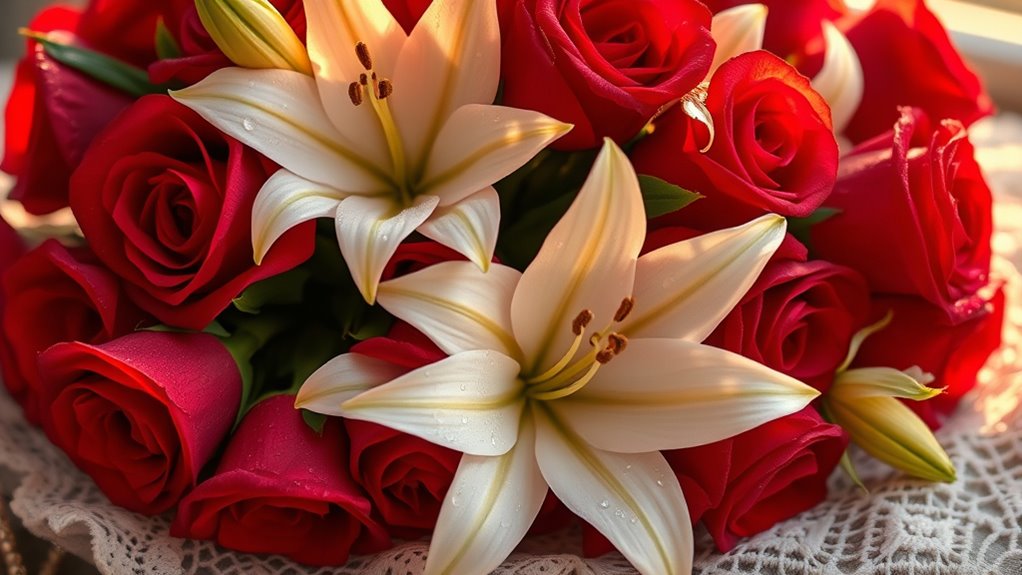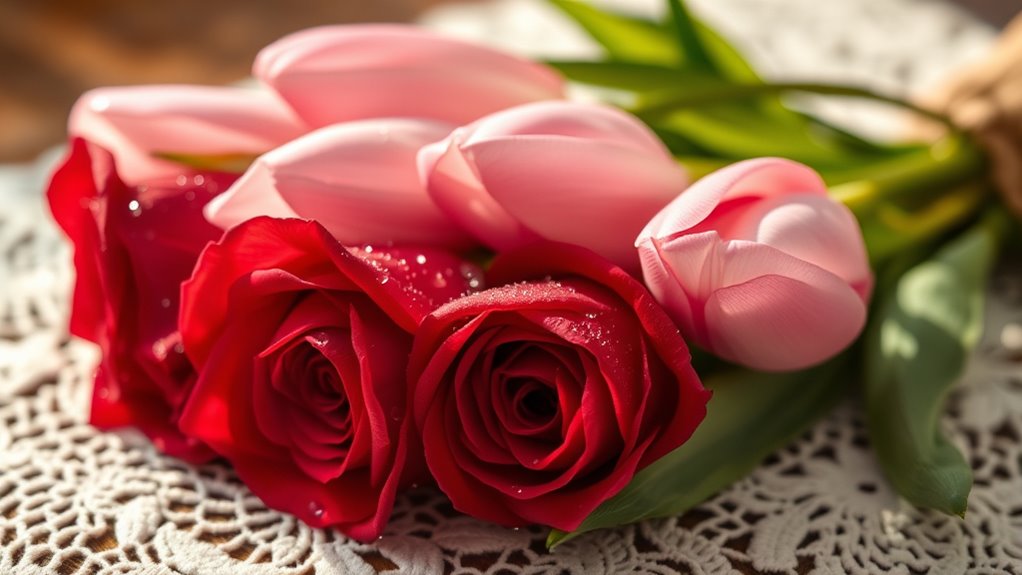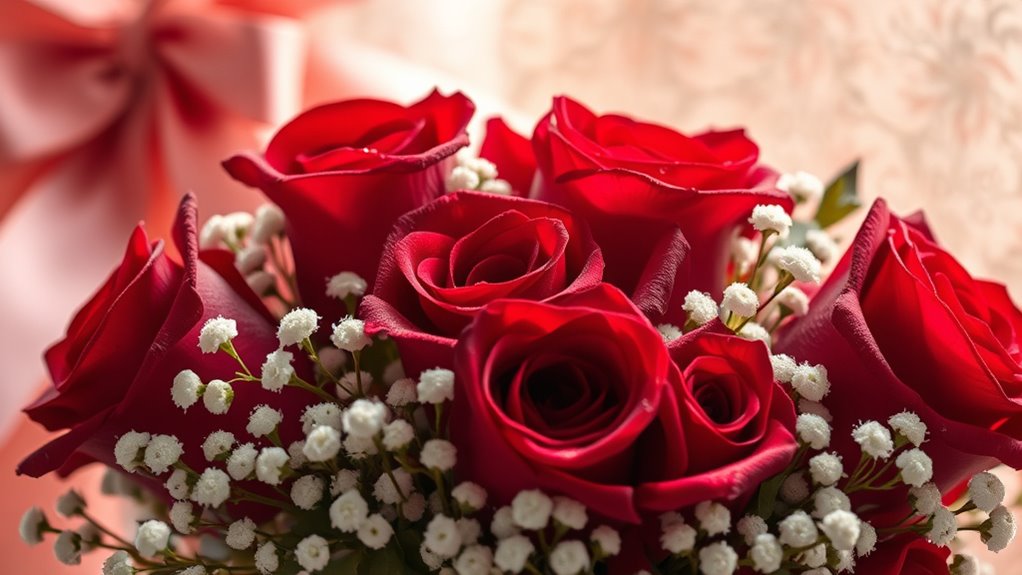Flowers have traditionally symbolized love and affection on Valentine’s Day, with origins rooted in ancient customs like Roman festivals. Red roses stand for passion, while other flowers carry meanings of admiration, purity, or loyalty. Cultures vary in their floral symbols and colors, adding depth to your gift. Modern trends focus on unique designs and eco-friendly options that reflect personal values. If you keep exploring, you’ll uncover even more ways flowers express your feelings.
Key Takeaways
- Flowers symbolize love, passion, and admiration, playing a central role in expressing affection during Valentine’s Day traditions.
- Different flowers and colors have specific meanings, enhancing personalized and culturally meaningful gifts.
- The tradition dates back to ancient festivals and courtly love, evolving with trade and cultural influences.
- Modern trends emphasize sustainable, eco-friendly floral arrangements and unique, personalized designs.
- Flowers continue to reinforce emotional messages, making them a timeless and meaningful gesture of love.
Historical Roots of Flower Giving on Valentine’s Day

The tradition of giving flowers on Valentine’s Day dates back centuries and is rooted in both ancient customs and evolving cultural practices. Long ago, the Romans celebrated Lupercalia, a fertility festival where flowers symbolized love and new beginnings. During the Middle Ages, flowers became a way to communicate feelings, especially when courtly love was hidden or unspoken. By the 17th century, elaborate floral gifts gained popularity among European aristocracy, reinforcing their significance as symbols of affection. As trade routes expanded, exotic flowers like roses and lilies became more accessible, further embedding floral giving into romantic traditions. Over time, flowers transformed from mere symbols to meaningful tokens of love, becoming an integral part of Valentine’s Day celebrations across cultures worldwide. The flower symbolism associated with different blooms also deepened the emotional impact of these gifts, making floral expressions of love even more personal and meaningful. Additionally, the historical evolution of floral symbolism reflects changing attitudes toward love and romance throughout history. The cultural significance of certain flowers, such as roses and violets, has been shaped by their unique histories and symbolic meanings, enriching the tradition of flower giving.
Symbolism Behind Popular Valentine’s Day Flowers

Many of the flowers exchanged on Valentine’s Day carry rich symbolic meanings that deepen their significance. For example, red roses represent love and passion, making them the perfect romantic gesture. Pink carnations symbolize admiration and gratitude, while lilies often stand for purity and devotion. Understanding these meanings helps you choose flowers that truly express your feelings. Here’s a quick guide to common Valentine’s Day flowers and their symbols: cybersecurity vulnerabilities
| Flower | Symbolic Meaning | Best For |
|---|---|---|
| Red Rose | Love, passion | Romantic love |
| Pink Carnation | Admiration, gratitude | Appreciation, friendship |
| Lily | Purity, devotion | Respect, sincere affection |
| Violet | Faithfulness, modesty | Loyalty, gentle love |
Choosing flowers with meaningful symbolism adds depth to your gift and makes your expression of love more personal.
Cultural Variations in Flower Traditions

You’ll notice that different cultures have unique flower traditions for Valentine’s Day. In Western countries, roses symbolize love and passion, while in many Asian cultures, flowers are given with specific meanings and customs. These variations reflect how deeply flower symbolism varies around the world. Recognizing cultural significance can enhance understanding and appreciation of these diverse floral gestures. Additionally, understanding flower symbolism can help individuals choose meaningful gifts that resonate with cultural traditions. For example, the color of flowers can also carry different connotations depending on the region, further enriching the cultural context of floral expressions.
Western Symbolism of Roses
Roses have long been a powerful symbol of love and passion in Western cultures, especially around Valentine’s Day. They represent deep emotions, romance, and admiration. The red rose, in particular, is associated with love and desire, making it the perfect gift for expressing your affection. Over time, different rose colors have gained specific meanings, allowing you to convey nuanced sentiments through your choice of flower. For example, white roses symbolize purity, while yellow roses stand for friendship. Roses are often used in romantic gestures, from bouquets to decorations, emphasizing their importance in Western traditions. They also feature prominently in art and literature as symbols of love’s beauty and complexity. Additionally, the tradition of giving roses has been influenced by flower symbolism, which varies across cultures but often highlights the universal language of flowers in expressing emotions. Understanding the cultural significance of different flowers can deepen the meaning behind your floral gifts. Incorporating mindset principles such as gratitude and positive intention can further enhance the emotional impact of your gesture. Furthermore, the variety of flower styles available allows for personalized and meaningful expressions of affection. Recognizing the cultural variations in flower traditions can help you select flowers that resonate more deeply with your recipient’s background and values.
Asian Flower Gift Customs
In Asian cultures, flower gift-giving carries rich symbolic meanings that vary widely across regions. In Japan, you might give cherry blossoms to convey admiration and fleeting beauty, while in China, orchids symbolize refinement and love. During Lunar New Year and Valentine’s Day, flowers are carefully chosen to match the message you want to send. In Korea, carnations are popular for expressing deep affection and respect. You should also be aware that the color of the flowers matters: red often signifies passion, whereas white can represent purity or mourning. Gift-giving customs emphasize thoughtfulness, so selecting flowers based on cultural meanings shows your respect and understanding. Additionally, understanding flower symbolism can deepen the sincerity of your gesture. Moreover, incorporating creative practice into your flower selection process can help you craft more meaningful and personalized gifts. Recognizing cultural variations in flower meanings allows for more thoughtful and culturally appropriate gift-giving. Understanding the cultural context behind flower choices can further enhance the emotional impact of your gift. For example, being aware of recent flower trends in certain regions can help you choose more contemporary and appreciated gifts. Overall, Asian flower traditions focus on conveying heartfelt emotions through carefully chosen blooms that reflect cultural values.
The Significance of Red Roses in Romantic Gestures

Red roses have long been cherished as a powerful symbol of love and passion, making them a popular choice for romantic gestures on Valentine’s Day. When you give someone red roses, you’re expressing deep affection and desire without words. Their vibrant color symbolizes love, while their fragrance evokes intimacy. Red roses also convey respect and admiration, making them versatile for various romantic contexts. Choosing a bouquet of red roses shows thoughtfulness and sincerity, often sparking emotional connections.
- Signify love and romance instantly
- Convey admiration and respect
- Evoke feelings of passion and desire
- Serve as timeless symbols of devotion
Modern Trends in Valentine’s Day Floral Arrangements

You’ll notice that eco-friendly flower options are gaining popularity, allowing you to celebrate with sustainability in mind. Unique arrangement styles, like asymmetrical designs or dried flowers, are also making a statement. These modern trends give you fresh ways to express your love creatively and thoughtfully. Incorporating sustainable gardening practices into your floral choices can further enhance your eco-conscious celebration. Additionally, choosing flowers with reduced environmental impact can make your gesture even more meaningful, especially when considering flower sourcing methods that prioritize ethical and eco-friendly cultivation. Recognizing the importance of global entertainment industry influences can inspire you to select flowers that support fair trade and responsible farming. Embracing ethical sourcing ensures your floral gifts align with your values and promote positive change in the industry.
Eco-Friendly Flower Options
As awareness of environmental impact grows, many people are choosing eco-friendly flower options for Valentine’s Day. You can make a positive impact by selecting sustainably grown flowers that reduce water use and pesticide reliance. Local farms often provide fresher blooms with a smaller carbon footprint, so consider buying from nearby sources. Additionally, opting for potted plants or flowers that can be replanted extends their life and benefits the environment. Look for certifications like Fair Trade or Rainforest Alliance to ensure ethical practices. Using biodegradable wrapping and minimal plastic packaging also helps lessen waste. By choosing these eco-conscious options, you celebrate love while supporting sustainable agriculture and protecting the planet. Incorporating sustainable practices in your floral choices not only benefits the environment but also aligns with the growing trend of responsible consumerism. Moreover, selecting flowers that are grown with minimal chemical intervention can further reduce environmental impact and promote healthier ecosystems. Being mindful of local sourcing can also help lower transportation emissions and support regional farmers. Additionally, choosing flowers that are produced with water conservation techniques can significantly lessen their environmental footprint.
Unique Arrangement Styles
Modern Valentine’s Day floral arrangements are shifting away from traditional styles, embracing innovative designs that make a bold statement. You might see arrangements that break the mold with asymmetrical shapes, unexpected color combinations, or mixed media elements like jewelry or fairy lights. Instead of classic round bouquets, you could opt for vertical or sculptural designs that stand out. Techniques like cascading blooms, geometric shapes, or even miniature gardens bring fresh energy to your gift. These unique styles allow you to personalize your expression of love, making your gesture more memorable. You’re encouraged to explore unconventional arrangements that reflect your recipient’s personality and your creative flair. By choosing modern, distinctive designs, you elevate your Valentine’s Day gift into a piece of art that captures attention and admiration.
Choosing the Perfect Flowers to Express Your Feelings

Choosing the right flowers to express your feelings requires understanding the symbolism behind different blooms. For example, red roses symbolize love and passion, making them perfect for romantic gestures. Pink flowers convey admiration and gratitude, ideal for showing appreciation. White blooms represent purity and innocence, suitable for new beginnings or sincere apologies. Yellow flowers express friendship and joy, great for celebrating camaraderie. Consider what message you want to send and select flowers that match that sentiment. Think about the recipient’s preferences too—if they love bold colors or subtle tones. Ultimately, choosing flowers that align with your feelings helps convey your message clearly and authentically.
Choosing flowers that match your feelings helps convey your message with clarity and sincerity.
- Red roses for love and passion
- Pink flowers for admiration
- White blooms for purity
- Yellow flowers for friendship
Frequently Asked Questions
How Have Flower Prices Changed Over the Years for Valentine’S Day?
You might notice that flower prices for Valentine’s Day have fluctuated over the years. Typically, demand peaks around February 14th, causing prices to rise. Factors like weather, supply chain issues, and seasonal availability also influence costs. While some years see modest increases, others experience significant jumps, especially for popular blooms like roses. Planning ahead or choosing alternative flowers can help you save money and still celebrate love beautifully.
Are There Specific Flowers Associated With Different Types of Love?
Like a painter choosing colors, you’ll find specific flowers symbolize different kinds of love. Red roses are your classic symbol of passionate love, while pink roses express admiration and gratitude. Yellow flowers, like daffodils, symbolize friendship and joy, and white lilies represent purity and innocence. You can choose these blooms to convey your feelings perfectly, making your gift more meaningful and personal.
Do Flowers Have Different Meanings in Non-Western Cultures?
You might wonder if flowers carry different meanings in non-western cultures. Yes, they do. For example, in Japan, cherry blossoms symbolize the fleeting beauty of life, while in China, peonies represent prosperity and honor. In India, marigolds are used in religious ceremonies and symbolize auspiciousness. Understanding these cultural differences helps you appreciate how flowers convey unique messages around the world, beyond just western traditions.
How Do Environmental Concerns Influence Floral Choices on Valentine’S Day?
You might choose eco-friendly flowers for Valentine’s Day to reduce environmental impact. Knowing that traditional roses often come from long-distance imports, you could opt for locally grown or organic blooms. This shows your care for the planet while still expressing love. By selecting sustainable options, you support environmentally responsible farming and reduce carbon footprints, making your gesture both meaningful and eco-conscious.
What Are Some Unique or Unconventional Flowers Used in Modern Valentine’S Arrangements?
You might choose unique flowers like succulents, anthuriums, or proteas to stand out in modern Valentine’s arrangements. These unconventional options add a fresh, contemporary twist to traditional bouquets. You can also opt for exotic blooms or dried flowers to create textured, lasting displays. By selecting these distinctive flowers, you personalize your gift and showcase creativity, making your Valentine’s Day gesture memorable and meaningful.
Conclusion
As you pick the perfect flowers this Valentine’s Day, remember that these blooms are more than just pretty faces—they’re timeless symbols of love, dating back to the days of courtly romances and even the ancient world. Whether you choose a classic red rose or a unique bouquet, your gesture speaks volumes. Think of it as sending a love letter with petals, a tradition that’s endured longer than the first printing press, making your message truly timeless.








